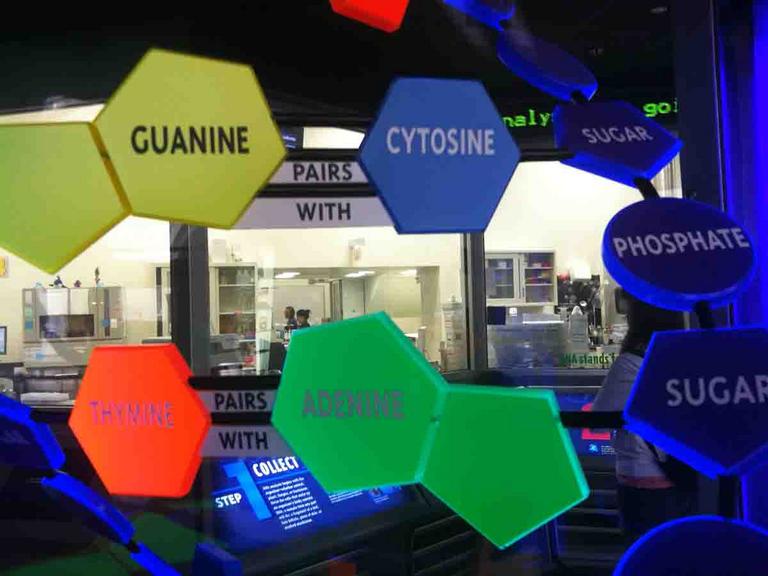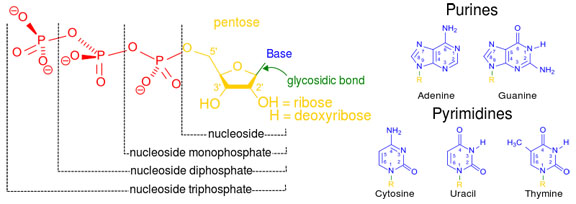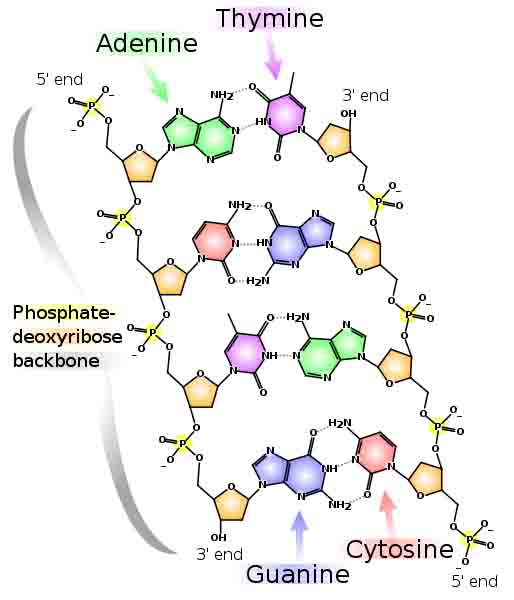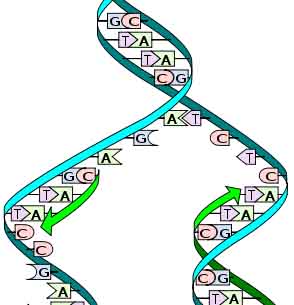 | ||||
Deoxyribonucleic Acid Structure
What Is DNA?
CLASS NOTES from Science Prof Online
Nucleotides are the small organic molecules that, when put together, become nucleic acids. Each nucleotide has three main parts:
- a pentose sugar called ribose
- one or more phosphate groups
- one of five cyclic nitrogenous bases
Article Summary: DNA(deoxyribonucleic acid) is the genetic blueprint of all life. Here are the basics of its construction and function.
What Is DNA?
 | ||||
The Virtual Microbiology Classroom provides a wide range of free educational resources including PowerPoint Lectures, Study Guides, Review Questions and Practice Test Questions.
Phosphate-Sugar Backbone
Nucleotides are linked to each other by covalent bonds between phosphate of one nucleotide and sugar of next. Linked nucleotides are the phosphate-sugar backbone of nucleic acids, and their nitrogenous bases extend from this phosphate-sugar backbone like teeth of a comb.
The Nucleic Acid “Ladder”
In DNA, hydrogen bonds form between specific bases of two nucleic acid chains, forming a twisted, double-stranded DNA molecule that looks like a spiral staircase, with the two sugar-phosphate chains as side rails and the base pairs forming the rungs.
There are four different types of nitrogenous bases found in a DNA molecule: adenine (A), guanine (G), cytosine (C) and thymine (T). Adenine and guanine are larger, double ring nitrogenous bases called purines. Cytosine and thymine are smaller, single ring nitrogenous bases called pyrimidines. When bases pair up between the two DNA strands, a purine always pairs with a pyrimidine. Specifically adenine (A) and thymine (T) pair up, and cytosine (C) and guanine (G) pair up. These bases are attracted to each other through hydrogen bonding.
When the DNA molecule is inactive, the bases are linked by these hydrogen bonds and the molecule is in its spiral-shaped state. When DNA is being used—either being copied (a process called replication) or being employed to build proteins (involving the processes of transcription and translation)—the DNA molecule must be opened up, essentially “unzipped” between the bases.
How Do Nucleotides Put Themselves Together Into Nucleic Acids?
The construction of a nucleic acid is an anabolic polymerization process. Anabolic reactions use energy to build bigger molecules. Polymerization is the process of taking monomers, such as nucleotides, and putting them together into polymers (large molecules composed of many monomers).
To learn more about the structure and function of DNA see the following animations and SPO Class Note Articles:
Animations
- DNA Structure Cell Biology Animation from John Kyrk.
- Build a DNA Molecule from University of Utah.
- DNA Replication animation and review questions.
- DNA Replication Process animated video by FreeScienceLectures.com.
- DNA Replication step-through animation by John Kyrk.
Class Notes
- Ribonucleic Acid Structure & Function - What Is RNA and What Does It Do?
- What Are Nucleotides & Nucleic Acids? Structure and Function of DNA, RNA and ATP
- Nucleic Acid Function of DNA & RNA: Genetic Replication, Transcription & Translation
Sources
- Bauman, R. (2005) Microbiology. Pearson Benjamin Cummings.
- Park Talaro, K. (2008) Foundations in Microbiology, McGraw-Hill.
- Campbell, N. & Reece, J. (2002) Biology, 6th Edition, Benjamin Cummings.
 | ||||||
You have free access to a large collection of materials used in a college-level introductory Cell Biology Course. The Virtual Cell Biology Classroom provides a wide range of free educational resources including Power Point Lectures, Study Guides, Review Questions and Practice Test Questions.
The nucleotide building blocks of DNA are triphosphates (nucleotides with three phosphates) and energy is stored in the bonds that link the phosphates together. When one of these phosphate bonds break, this provides the energy to add that nucleotide to the growing nucleic acid molecule.
 | ||||||
SPO VIRTUAL CLASSROOMS
Portions of this article originally appeared on Suite101 online magazine.
Page last updated: 10/2012
 | ||||||
SPO is a FREE science education website. Donations are key in helping us provide this resource with fewer ads.
Please help!
(This donation link uses PayPal on a secure connection.)







